ChiselA chisel is a type of cutting tool with a sharpened edge at the end. It is also used as a shaping tool. We can say that chisel is used to shape and cut wood, metals, and stone. It is a hand-held tool whose handle is made up of either wood or plastic. The chisel handle provides a better grip to hold the toll and perform the cutting and shaping operations. We can apply the force on the chisel either with mechanical power or by using the mallet. A chisel is a handheld tool, which is supported by a wooden or metal handle. The preferred material for the chisel handle is wood because the metal can harm the chisel edge attached to it, our fingers, and our hands. 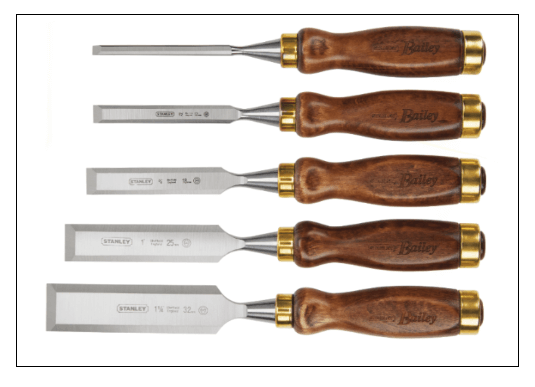
The cutting or shaping process is carried out by forcing the blade into the material using the hammer. Chisel is used since the historic period. Today, chisels are available in various sizes and shapes according to their different uses. Here, we will discuss the types of chisel, and the chisel process. Types of chiselChisels are often used in woodworking and metalworking. The small chisel tools are used for fine details in the wood, while extensive tools are used to remove big wood sections from the wood piece. Both small and large tools are required for designing the wood piece. Wood work chiselsThe types of woodworking chisels are categorized as follows:
Skew chiselIt is a long flat chisel with a slanted end, as shown below: 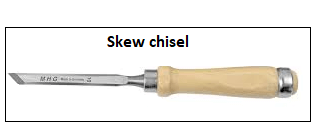
The shortest point of the chisel edge is known as the heel, while the long point is known as the toe. It is generally used for trimming and finishing. The skew edge of the chisel is hand-controlled and can be used for detailed work. Butt chiselThe butt chisel is a small version of the chisel, especially the firmer chisel. It is generally designed for butt hinge work. It is shown below: 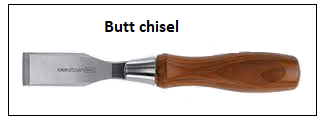
It has a large size and is used to remove out large areas. Corner chiselThe cutting edge of the corner chisel is L-shaped, which is used to clean corners, square holes. The angled of such type of the chisel is inclined at 90 degrees. It is also used to clean out the internal corners of the wood piece. 
Carving chiselCarving chisel is generally used for designing and sculpting. It is a good collection of various types of chisels used in the woodworking. It means that carving chisels has multiple functions, such as parting, cutting, paring, and skew. It is shown below: 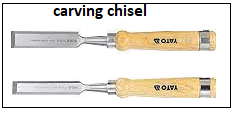
Flooring chiselAs the name implies, flooring chisels are used for the flooring purposes, such as cutting and removing flooring materials. The Flooring chisel is longer than other types of chisel. It is also suitable for tongue and grove flooring. The flooring chisel is shown below: 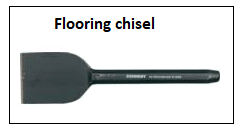
Framing chiselThe framing chisel is similar to the butt chisel but has a long and flexible blade. It is shown below: 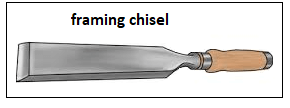
A framing chisel is used for carving and wood frame construction. Mortise chiselMortise chisel has tapered ends, deep and straight cutting edge, and a rigid blade. Mortise means a hole with the corresponding projection. It is specially designed for chopping the mortise. It can be directly used to lever out the waste material from the workpiece. Other chisels do not have the thickness that can make them easily lever out the material. It is shown below: 
Firmer chiselThe firmer chisel is heavier and stronger. It has a wider blade with a thick rectangular cross-section. It is one of the main chisels used in woodworking. The thicker and stronger blade can cut or remove larger parts of wood from the workpiece. It is shown below: 
When the firmer chisel is hit with the mallet, it can easily from large and deep cuts into the workpiece due to its sharp and strong ends. Paring chiselThe paring chisel is a long, flat, and thin chisel used to remove thin layers of the wood. The ends of the chisel are taping at one side. It has a sharp cutting edge than gives clean cuts. It is shown below: 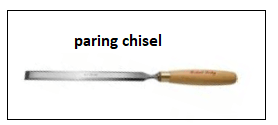
Metal work chiselsMetal work chisels are used to cut and shape metals. The chisels used in the metal work are categorized as cold chisels and hot chisels. Cold chiselsCold chisels are used to cut hard metals and remove waste from the metals surface. The cold chisel is used when other mechanical tools cannot complete the work. It has less acute angle shape at the end as compared to woodworking chisels. 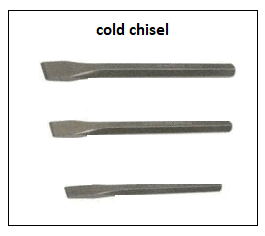
The cold chisel term came when the blacksmiths uses the cold chisel to cut the metal. It comes in variety of sizes. Some cold chisels are tapped with a light hammer, while some are tapped with a long and heavy hammer. Cold chisels are further categorized as:
Flat chisels It is a flat and tempered flat chisel. It is used to cut thick metal sheets when shear or other tools cannot cut. A flat chisel is generally made up of hard steel to maintain its flat finished surface easily. It is shown below: 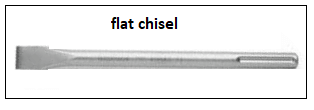
Diamond point chisel It has a sharp point and is used to clean out difficult corners or places. It is also used to pull out the center punch marks that mistakenly occur during the drilling process. 
Cross cut chisel It is also a chisel with pointed end. It is also known as ripping chisel and is used to cut wood, slots, and groves, as shown below: 
Round nose chisels As the name implies, the round nose chisel is used to cutting the semi-circular grooves for oil ways in bearings, as shown below: 
Hot chiselsThe hot chisel is used to cut the hot metal. The metal is first heated in the forge until it turns red. The red metal is known as hot metal. The metal is burnt at a temperature suitable for cutting and shaping. The metal to be cut or shape is placed over the chisel and hit with a hammer. After that, it is picked or carried using a pair of tongs. The hot metal work piece is further dipped in the water for cooling. But, what is the main difference between the cold chisel and the hot chisel? The cold chisel is hard or tempered because the metal being cut or shaped by it is hard. In the case of a hot chisel, the metal being cut is generally soft. Hence, the hot chisels are not as hard and tempered as compared to cold chisels. Other typesThe other types of chisel are categorized as stone chisels, masonry chisel, and gouge. Stone chiselsAs the name implies, stone chisels are used to cut the stones. It is also used to cut the bricks and the concrete slabs. The sculptors commonly use a spoon chisel (in the shape of a spoon). A force is applied to the chisel with the help of a hammer. A strong force requires a big hammer, while a light hammer is used to apply a light force on the workpiece. A type of stone chisel is shown below: 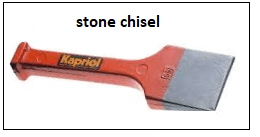
Masonry chiselsMasonry is a type of heavy chisel, which is used to break the workpieces. It is a dull chisel that is not meant to cut the workpiece. The weight of the mounted hammer is around three pounds or more. A masonry chisel is mounted with a hammer on the top, as shown below: 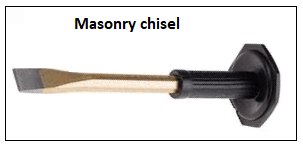
It is further categorized as flat chisels, flexible chisels, point chisels, etc. A flexible chisel has flexible blade and is easy to handle. The point chisel has a sharp end and is generally used for carving. GougeA gouge is similar to the chisel but has a curve end instead of a flat end. We can also say that gouge has an angled cross-section at the end. The blade is also attached to the handle made of wood or metal. The preferred material for the handle is wood because wood is safe for hands and fingers compared to the metal handle. Gouge with angled blades are known as 'V- gouges.' According to the curves of the different blades, each gouge is specified with a sweep number on it. For example, the gouge with sweep number 1 is flat, while the gouge with sweep number 9 is in the shape of a semi-circle. Similarly, gouge with sweep number 11 is U-shaped. Other shapes of the gouge blade include fishtail and spoon-bent. It is generally used in arts and woodwork. For example, Carving a violin and cutting art sheets. Other shapes of the gouge blade includes fishtail and spoon-bent. It is generally used in arts and wood work. For example, Carving a violin and cutting art sheets. 
Other shapes of the gouge blade includes fishtail and spoon-bent. It is generally used in arts and wood work. For example, Carving a violin and cutting art sheets. Chisel processLet's discuss how cutting or shaping is performed on wood, stone, and metals with the help of chisel. 1. Cutting a stone
Similarly, we can cut other tools like wood and metals. We can also create designs on it as per the requirements. Shaping the woodShaping is a process to cut the wood into the desired shape. We need to chop a small amount of wood from the wood piece at every cut for shaping. Some machines automatically perform the process. Here, we will discuss some common steps to shape the wood using the chisel.
Next TopicDensity formula
|
 For Videos Join Our Youtube Channel: Join Now
For Videos Join Our Youtube Channel: Join Now
Feedback
- Send your Feedback to [email protected]
Help Others, Please Share










